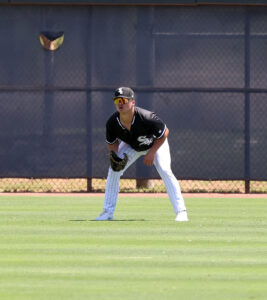Carson Fulmer and the right struggles

Going into the 2015 MLB Draft, Carson Fulmer was unanimously considered the most decorated college pitcher of the class. Fulmer was just about dominant in each of his three years at Vanderbilt, he was the ace of perhaps the best program in NCAA baseball and he was a College World Series champion to boot.
Despite an astounding resume, the right-hander did have some detractors going into the draft. But for the most part, even the detractors didn’t doubt his ability to pitch. They doubted his health, they doubted his high-effort delivery and they doubted his size, or lack of it. There was one team in the top ten picks of the draft that had a particular knack for not only keeping their players healthy, but also developing pitchers with less than desirable mechanics. When Carson Fulmer was selected by the Chicago White Sox with the 8th overall pick in the draft, the marriage was uncanny.
A year before drafting Fulmer, the White Sox selected the top college pitcher in that class when they drafted Carlos Rodon 3rd overall. Rodon, who was largely considered the biggest college pitching prospect since David Price, followed the footsteps of the last college starting pitcher the White Sox used their first pick on: Chris Sale. Both Sale and Rodon found their way to the big league roster by their first April as a professional. The White Sox don’t waste miles on the arms and believe the best players find the big leagues quickly, but these were two special lefties and no standard to go off of.
So when the White Sox fans learned what they had in Carson Fulmer, they came to our Future Sox Twitter account asking for an estimated arrival time. They didn’t want to know which year Fulmer would make his MLB debut; they wanted to know which month. Given the meteoric rises of Sale and Rodon, I asked White Sox General Manager Rick Hahn in January about Fulmer’s lofty expectations, “Is there reason that White Sox fans should be a little more cautious with Carson Fulmer?” Hahn responded:
“I think we’re spoiled. I think we’re all spoiled. The fact of the matter is, if Carson Fulmer contributes to the White Sox in 2017, that’s a really fast development path, much less 2016. But I get it, because you saw it with Rodon, you saw it with Sale…so I get it. I just think we need to keep a little bit of perspective that Sale and Rodon are the exceptions and Carson’s going to be a good one and he’s probably going to get here fast, but that doesn’t necessarily mean ’16” – Rick Hahn, January 2016.
So while the White Sox General Manager tempered expectations and offered a far more conventional path to Chicago for his young hurler, I’m sure he never would have guessed the 22-year-old would struggle the way he has out of the gate. To be clear, Fulmer has pitched in nine games and has yet to amass even fifty innings. But sample size be damned, the variance in his performance is hard to ignore. I think everyone gave Fulmer’s first few bad starts a pass and afforded the Future Sox’s #2 prospect some time to settle in. But given the expectations placed on Fulmer coming into this year, whether they are fair or not, his performance has raised big questions.
It’s been a long, long time since the White Sox had a blue chip prospect that took on a conventional, level-by-level path to the majors. While incredibly raw when drafted, we are now seeing it in an accelerated form with shortstop Tim Anderson. But other than Tim Anderson who has yet to the majors, the top prospects of White Sox recent history, like Sale, Rodon and Gordon Beckham, have flown almost right to Chicago just taking short layovers with the affiliates. That was what was expected of Fulmer. According to the fans, he was expected to replace John Danks as the fifth starter and he was supposed to help in the stretch of the 2016 season. So what happened?
A couple weeks ago, we had received a report from Birmingham that said Fulmer had tweaked his mechanics and looked noticeably different. This was enough for us to decide we had to dive into Fulmer’s 2016 season and try and figure out what was going on with the prized pitching prospect.
Without any video or scouting reports to go off (yet), I went to White Sox Assistant General Manager Buddy Bell to find out more on Fulmer. I asked Bell if Fulmer had any directives from the White Sox to make any mechanical changes this year. Bell apprised, “In Carson’s case, we really haven’t done anything…if anything we’ve just talked to him about staying a little bit taller to get a little more angle.” So I prodded on the supposed mechanical changes, “Is this something he has taken on himself?” Bell responded, “Anything he’s done up to this point, he’s doing on his own. Just like a hitter would.” In essence, Bell clarified that if there are any changes in Fulmer, they aren’t coming from the White Sox suggesting them. Later in our talk, Bell went on to illuminate some of the things Fulmer struggles with mechanically, but we’ll get to that later.
After speaking with Bell, the next person I sought out was J.R. Perdew. Perdew has been a pitching coach in the White Sox organization for the better part of two decades. Not only is Perdew Fulmer’s current pitching coach in Birmingham, but he was also the pitching coach at Winston-Salem last year where Fulmer spent the majority of his first short season as a pro. Perdew doesn’t see any changes in Fulmer either and even went as far as saying, “I think he’s the same guy really.” Perdew elaborated:
“He came in here with a lot of talent and obviously we’re not here to take that away from him. We want him to be himself and with the talent he brought from Vanderbilt – that ‘s what we want here too. We’re not going to change anything.”
Perdew ultimately believes that Fulmer is going through growing pains and embraced the idea that he could be struggling because he was used to pitching outside of the zone against the NCAA’s inferior talent. Certainly that idea, along with the fact that the jump from High-A to Double-A is largely considered the toughest for a minor leaguer, should not be ignored when evaluating Fulmer’s 2016. Perdew believes in not only the stuff from the high-energy Vandy stand-out, but even more so, the character he possesses. The Barons’ pitching coach reiterated his confidence in Fulmer, “I believe with his character and the person he is, he’ll get through anything that comes his way. I really believe that.”
The conversations with Bell and Perdew provided a foundation to grasp some of the quirks and intricacies of Fulmer as a pitcher, as well as the reiteration of the White Sox brass’ confidence in his makeup, but they couldn’t illuminate the physical changes Fulmer has made on the mound. It wasn’t until Mike Guzman, Kamp Fender and the good people with the Birmingham Barons provided us with game footage of Fulmer’s last start that we were really able to discern the changes with Fulmer out on the mound.
Needless to say, the idea of pitching mechanics is less of a science and more of a generally agreed upon practice. There’s merit and good reason behind the logic to them, but as Don Cooper would be the first to tell you, there’s no recipe so-to-speak. Every pitcher is different and strong mechanics don’t promise a pitcher anything, nor do poor mechanics promise injury.
As a basis, below we have some footage from our Kim Contreras when she was able to tape Fulmer’s first professional appearance in the Arizona League on July 18th, 2015. Upon comparison, his method of throwing is consistent with what he showed at Vanderbilt as a junior. Then a second set of video being analyzed is from a recent start of Fulmer’s on May 21st, 2016. Take a look at the tape, one after the other…

Video – Kim Contreras/FutureSox

Video – Kamp Fender/Birmingham Barons
Looking at the later (2016) GIF/tape, the mechanics are a lot closer to what is popularly considered “good pitching mechanics.” The aforementioned imperfections are either less pronounced, or nearly mitigated as a whole. So it would seem, considering the White Sox personnel’s words and utilizing the video at hand, that Fulmer has taken it upon himself clean up some of the relative blemishes that make up his mechanics. As a result, Fulmer has had a loss consistency in his delivery and is less balanced as he adjusts. Not only that, but there is much more variability in the way he pitches from the windup and how he pitches from the stretch.
|
7/18/2015 – AZL |
5/21/2016 – Double-A |
|
| SET UP |
|
|
| WINDUP |
|
|
| LEG LIFT |
|
|
| STRIDE |
|
|
| LANDING POINT |
|
|
| ROTATION AND FOLLOW THROUGH |
|
|
Putting the increase in competition aside for a moment, you can see that Fulmer is also dealing with the changes of his mechanics. Watching the tape from his May start, you can really see the balance and inconsistency during and after release. His setup and windup, while simple either way, are clearly different. He’s more open, which would go against the philosophy of the White Sox scouts and pitching evaluators, but at the same time, he’s better serving himself to stay linear during extension. Another quirk is his action with his glove prior when gearing up. It almost seems like the speed and distance covered with his glove prior to separation varies in every pitch. While this could be a complexity to bring deception, it also seems to make it harder for Fulmer to keep his lower half and upper half in unison. This was also something Buddy Bell acknowledged Fulmer could get better with.
Fulmer’s actions between the leg lift and his landing point would in theory, seem to be the biggest improvement in his mechanics. Everything he does is more efficient and better assists Fulmer in keeping his movement either linear or sideways. There is far less inefficient movement around his leg lift and less of an imbalance when he’s cock back to generate power. Instead of showing the thrust kick towards the third base dugout, Fulmer is showing a table close to the 90° table that is popularly encouraged. He doesn’t quite mirror the type drop-and-drive leg action that Roger Clemens exhibited during his career, but Fulmer has seriously quieted down the action of his lead foot as he works top down.
Fulmer’s arm acceleration moving to release is largely the same as it was in the past. Given his size, he’s never going to have perfectly clean mechanics without generating velocity and Fulmer’s extension, drive and toe drag is principal in enabling him to get the most of his body.
The finish is ultimately what I think may be leading to some of the trouble for Fulmer and inability to mirror his mechanics pitch-to-pitch. To my view, the changes are clear improvements from a mechanical standpoint, but they are a foreign set of movements to Fulmer and his balance has ebbed away as a result. The unnecessary head whack has lessened, at least from his windup, and that is inarguably a good thing. Past that, Fulmer is getting far better rotation from his truck and his arm action when following through. These new actions are counterbalancing the weighty amount of torque and stress Fulmer was putting on his shoulder but simultaneously causing him to lose balance. The hope would be this issue is just an issue in the interim, as his body gets the feel for his new changes.
Buddy Bell had referenced some the issues the White Sox have been pointing out to Fulmer. Issues like the inconsistent tempo of his hands prior to separation and how he sometimes starts “yanking balls.” I take this to be a reference of Fulmer opening up early and ultimately losing his balance. He has shown a tendency to fall off to the 1st base side and even has to catch himself at points. Last year, Fulmer would cut himself off on the other side of the mound so it is clear difference. Where Fulmer’s lack of rotation at finish in his Vanderbilt days was produced with consistency and strong results, Fulmer’s mechanical tweaks during 2016 have brought him the inconsistency and struggles.


Another thing we picked up on, while there’s less tape to go off of, is shown above with Fulmer’s change in his mechanics when pitching from the stretch. Obviously, every pitcher varies in this respect but Fulmer’s contrast is clear and there certainly seems to be more of a conscious effort to limit the opposition’s run game. While he is much quicker to the plate and ditches his leg kick for a slide, he is losing some of the benefits of his mechanical changes from the windup and creating further inconsistency in his deliveries to the place. He is helping his catcher in the run game, but seemingly putting some inordinate amount of strain his arm.
It goes without saying but: I am no expert and I don’t claim to be. To continue stating the obvious, scouting or analyzing video is nowhere near as effective as what an in-person perspective would provide. Regardless, the changes Fulmer has made are becoming more clear when you break down the video at hand frame-by-frame.
To close, it would seem Fulmer has made changes that would, in theory, aid his long-term career and increase his chances of being the type of guy who could throw 200 innings in a season. While he’s going through some growing pains and trying to harness the feel of his changed mechanics, I will heed Rick Hahn’s advice and look at this with the perspective required. On that note, looking at the 2015 MLB Draft’s first round, Fulmer is the only pitcher to surpass A-ball at this point.
Despite his struggles, Fulmer is still a guy with a nasty fastball-curveball combination and an improving change-up to back it up. His coaches and the personnel of the White Sox can’t even talk about Fulmer without mentioning the fact that they would be honored to have the twenty-two-year-old marry one of their daughters. The stuff is there, the makeup is there and he’s situated in one of the best pitching incubators in the league. Ultimately, if Fulmer is able to harness these mechanical changes, the difficulties he has gone through could be the blessing in disguise that ultimately empowers him to be able to take the ball every fifth day on an annual basis for the White Sox in Chicago.
***In case you want to see the full video of Fulmer from the Barons, you can go to our YouTube channel and check it out.
Want to know right away when we publish a new article? Type your email address in the box and click the “create subscription” button. Our list is completely spam free, and you can opt out at any time.





